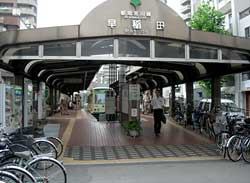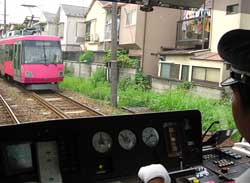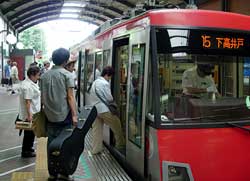Kids Web Japan
Web Japan > Kids Web Japan > Travel > Discovering Japan by Train > Tokyo by Trolley
Travel
Discovering Japan by Train
Tokyo by Trolley
We can even experience a taste of Tokyo on our little trip. Long ago, trams and cars ran side-by-side on the roads of central Tokyo. As the number of cars increased, trams came to be replaced by buses and subways. However, a few of these trams still remain.


The line runs on roads in some places (above); Waseda Station (below).
Toden Arakawa Line
The Toden-Arakawa Line is the last of the tram lines in Tokyo, and it stretches 12.2 kilometers from Minowabashi in Arakawa to Waseda in Shinjuku. The train makes 30 stops, each about two minutes apart. And even though it's a train, it stops at red lights when running on roads alongside cars.
The line passes by many schools, so it gets pretty crowded during the morning commute. During rush hour, trains run every two-and-a-half minutes. Used by 57,000 people each day, it's a convenient way for locals to get around.
The Toden Line has many sharp curves and changes of elevation. As such, cars cannot be attached together, so the trains run one car at a time. The entrance to the train is almost at the same level as the ground, making it easy for elderly people to use. The train's unique signal sounds as it weaves through the streets at an average speed of 18 kilometers per hour.


This line runs right by some houses (abobe); local people rely on the line (below).
Tokyu Setagaya Line
The Tokyu Setagaya Line runs through a residential area of Tokyo. It's a small two-track line that runs through 10 stations, starting from Shimo-takaido and ending at Sangenjaya in Setagaya Ward. With a one-way trip lasting just 17 minutes, it reaches the end before you know it. Most of the ride takes place along ordinary railway track, but the trains run along the street in places where the line intersects with a highway.
The two-car train is colorful, sporting 10 colors. A group of girls on their way home from school club activities engage in lively conversation. Just a few steps and they're back on the road. Its convenience is what makes the line so great.
The train runs by Gotoku Temple, famous as the birthplace of the maneki neko, or beckoning cat (statues of which are placed in homes to attract happiness and in stores to welcome customers); the Shoin Temple, which is revered as the god of learning and is connected with Yoshida Shoin, who dedicated himself to educating young people at the time of the Meiji Restoration; and Hachimangu in Setagaya, famous for its autumn sumo tournament (held on September 15 each year). This is a great area to take a stroll and imagine what Japan of old must have been like.